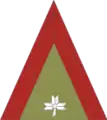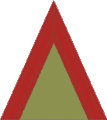Croatian Armed Forces (Independent State of Croatia)
The Croatian Armed Forces were formed in 1944 with the uniting of the Army of the Independent State of Croatia and the Ustaše militia in the Independent State of Croatia. It was established by the fascist regime of Ante Pavelić in the Independent State of Croatia (NDH), an Axis puppet state in Yugoslavia during World War II.
| Croatian Armed Forces | |
|---|---|
| Hrvatske oružane snage | |
.svg.png.webp) The war flag of the Independent State of Croatia. | |
| Founded | 1944 |
| Disbanded | 1945 |
| Leadership | |
| Poglavnik | Ante Pavelić |
| Minister of the Armed Forces | Nikola Steinfel |
| Industry | |
| Foreign suppliers | |
| Related articles | |
| Ranks | Military ranks of the Independent State of Croatia |
The Croatian Armed Forces (Croatian: Hrvatske oružane snage, HOS) was reorganized in November 1944 to combine the units of the Ustaše and Domobrani into eighteen divisions, comprising 13 infantry, two mountain, two assault and one replacement Croatian divisions, each with its own organic artillery and other support units. There were also several armoured units, equipped in late 1944 with 20 Pz IIIN and 15 Pz IVF and H medium tanks.[1] From early 1945, the Croatian divisions were allocated to various German corps and by March 1945 were holding the Southern Front.[2] Securing the rear areas were some 32,000 men of the Croatian Gendarmerie (Hrvatsko Oružništvo), organised into 5 Police Volunteer Regiments plus 15 independent battalions, equipped with standard light infantry weapons, including mortars.[3]
By the end of March, 1945, it was obvious to the Army command that, although the front remained intact, they would eventually be defeated by sheer lack of ammunition. For this reason, the decision was made to retreat across the border into the Austrian part of the Third Reich, in order to surrender to the British forces advancing north from Italy.[4]
Croatian Home Guard
Ustaše Militia
Croatian Gendarmerie
The Croatian Gendarmerie (Hrvatsko Oružništvo) was formed on 30 April 1941 as rural police under Major-General Milan Miesler. By September 1943, there were 18,000 men in seven regional regiments. These were divided into 23 companies (one per county plus one for Zagreb). The companies were subdivided into 142 district platoons, each with several posts. In early 1942, a three-battalion Combined Gendarmie Regiment, in July redesignated Petrinja Brigade, was established for anti-Partisan operations in Slavonia.[5]Twelve of the independent Police Volunteer Battalions formed the Croatian Gendarmerie Division in 1945.[6]
History
Marching order at end of 1944
- 1. Poglavnik Bodyguard Division
- 1. Croatian Assault Division
- Commander: General Ante Moškov
- Headquarters: Zagreb
- 2. Croatian Infantry Division
- Commander: General Mirko Gregurić
- Headquarters: Zagreb
- 3. Croatian Infantry Division
- Commander: General Stjepan Mifek
- Headquarters: Vinkovci
- 4. Croatian Infantry Division
- Commander: General Antun Nardelli
- Headquarters: Dvor na Uni
- 5. Croatian Assault Division
- Commander: General Rafael Boban
- Headquarters: Bjelovar
- 6. Croatian Infantry Division
- Commander: General Vladimir Metikoš
- Headquarters: Banja Luka
- 7. Croatian Mountain Division
- Commander: General Stjepan Perčić
- Headquarters: Nova Kapela, Batrina
- 8. Croatian Infantry Division
- Commander: General Roman Domanik
- Headquarters: Sarajevo
- 9. Croatian Mountain Division
- Commander: General Božidar Zorn
- Headquarters: Mostar
- 10. Croatian Infantry Division
- Commander: General Ivan Tomašević
- Headquarters: Bihać
- 11. Croatian Infantry Division
- Commander: Colonel Juraj Rukavina
- Headquarters: Gospić
- 12. Croatian Infantry Division
- Commander: Colonel Slavko Cesarić
- Headquarters: Brčko
- 13. Croatian Infantry Division
- Commander: General Tomislav Rolf
- Headquarters: Karlovac
- 14. Croatian Infantry Division
- Commander: Colonel Jaroslav Šotola
- Headquarters: Brod na Savi
- 15. Croatian Infantry Division
- Commander: General Zorko Čudina
- Headquarters: Doboj
- 16. Croatian Replacement Division
- Commander: General Milivoj Durbešić
- Headquarters: Zagreb
- 18. Croatian Infantry Division
Fate of Commanders
Executed
- Ante Moškov
- Mirko Gregurić
- Stjepan Mifek
- Antun Nardelli
- Vladimir Metikoš
- Roman Domanik
- Božidar Zorn
- Ivan Tomašević
- Juraj Rukavina
- Zorko Čudina
- Mijo Škoro
Unclear
- Rafael Boban
- Jaroslav Šotola
- Milivoj Durbešić
Emigrated
- Stjepan Peričić
- Slavko Cesarić
Committed suicide
- Tomislav Rolf
Ranks and insignia
 General pukovnik (Colonel General)
General pukovnik (Colonel General) General poručnik (Lieutenant General)
General poručnik (Lieutenant General) General (General)
General (General) Pukovnik (Colonel)
Pukovnik (Colonel) Podpukovnik (Lieutenant Colonel)
Podpukovnik (Lieutenant Colonel) Bojnik (Major)
Bojnik (Major) Nadsatnik (Senior Captain)
Nadsatnik (Senior Captain) Satnik (Captain)
Satnik (Captain) Natporučnik (Lieutenant)
Natporučnik (Lieutenant) Poručnik (Second Lieutenant)
Poručnik (Second Lieutenant) Zastavnik (Ensign)
Zastavnik (Ensign) Časnički namjesnik (Warrant Officer)
Časnički namjesnik (Warrant Officer) Stožerni stražnik (Staff Sergeant)
Stožerni stražnik (Staff Sergeant) Stražnik (Sergeant)
Stražnik (Sergeant) Vodnik (Lance Sergeant)
Vodnik (Lance Sergeant) Rojnik (Corporal)
Rojnik (Corporal) Dorojnik (Lance Corporal)
Dorojnik (Lance Corporal) Strielac (Private first class)
Strielac (Private first class) Vojnik (Private)
Vojnik (Private)
References
- Zaloga 2013, p. 44.
- Thomas 1995, p. 17.
- Thomas 1995, p. 30.
- Shaw 1973, p. 101.
- Thomas 1995, p. 20.
- Thomas 1983, p. 22.
Bibliography
- Shaw, Les (1973). Trial by slander; a background to the Independent State of Croatia, and an account of the Anti-Croatian Campaign in Australia. Canberra: Harp Books. ISBN 0-909432-00-7.
- Thomas, Nigel (1983). Partisan warfare 1941-45. Osprey. ISBN 0-85045-513-8.
- Thomas, Nigel (1995). Axis forces in Yugoslavia, 1941-5. London: Osprey. ISBN 1-85532-473-3.
- Zaloga, Steve (2013). Tanks of Hitler's eastern allies 1941-45. Oxford. ISBN 978-1-78096-022-7.
{{cite book}}: CS1 maint: location missing publisher (link)